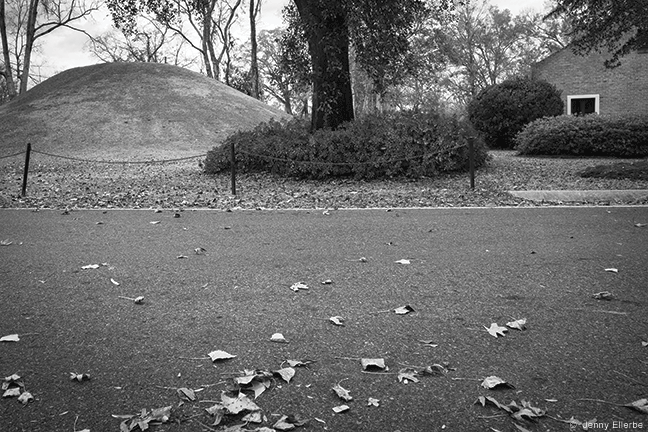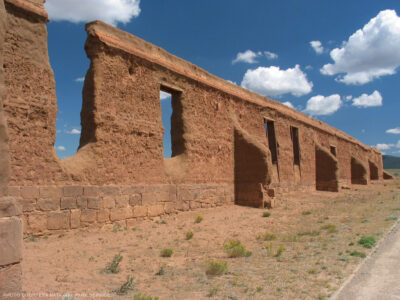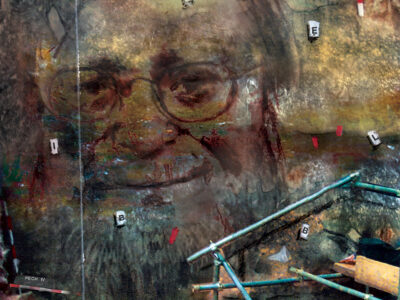
The Penn Museum explores North American moundbuilders, from ancient times to the present day.
Three massive birds soar across a rise in thick oak and hickory forest, their wingspans nearly the length of three tennis courts lined end-to-end. Their heads point east, toward the Mississippi River, which forms a natural border between Wisconsin and Iowa about a third of a mile away. They are avian sentinels to 10 bears, as big as houses, that march parallel to the river in single file. Their saunter south mimics the river’s flow and sinuous form.
These giants are called the Marching Bear Group: earthen mounds dating to the Late Woodland Period, between 1,500 to 1,000 years ago. They are just several of roughly 200 earthworks at Effigy Mound National Monument. Abstracted birds, bears, deer, bison, lynx, turtles, and panthers romp across a wide area of the upper Mississippi Valley and beyond. In all, some 4,000 effigy mounds survive in eastern North America, out of what may once have been over 20,000. And those are just the effigy mounds.
“A lot of people in the United States don’t even know that mounds exist,” says Megan Kassabaum, an assistant professor of anthropology and the Weingarten Assistant Curator in the Penn Museum’s American Section. “If they do know, they assume they’re all burial mounds, and they don’t really know about them or what they may have meant.”
Kassabaum curated the museum’s new exhibit, Moundbuilders: Ancient Architects of North America, which opened in September and runs through July 2018.
“The earliest mounds were built before Giza and Stonehenge,” Kassabaum says. “We want to show the wealth of eastern North America.”
The monumental mounds of the eastern United States comprise pyramidal, conical, and animal forms built by Native Americans beginning over 5,500 years ago and right up into the present—a remarkable continuity considering the violent and abrupt ruptures indigenous cultures suffered after European contact.
The earliest mounds preceded agriculture and were likely seasonal gathering places for various nomadic groups. People came together to feast, trade, forge marriages and other alliances, and perhaps perform important rituals. Later mounds incorporated burial rites as well. Effigy mounds like the Marching Bears may have represented clan symbols or totems, possibly marking territories.
Though often now covered by grass and forest growth, the early mounds originally stood out from the verdant forest and plains with striking mineral-toned surfaces of packed soil and clay. Building them was a ritual in its own right, involving many people—sometimes in the thousands—in coordinated efforts to dig and transfer tons of earth, stone, gravel, and clay using only stone tools and hand-carried baskets. These efforts endowed the landscape with meaningful features for the groups that built them.
The exhibit showcases over 2,100 objects from the museum, interspersed with evocative black-and-white landscape photographs by Jenny Ellerbe and Tom Patton that offer intimate perspectives of how people live among the mounds today. One image shows a walker passing over the top of an ancient mound overgrown by forest. Another reveals a house built right into a mound. Another depicts a golfer at The Moundbuilders’ Country Club in Newark, Ohio, putting in the midst of a mound site.
Ninety objects in the exhibit were excavated upwards of a century ago, from sites
ranging from Florida to Minnesota to Oklahoma. Many are beautiful effigy pots of human and animal forms along with stone tools, red jasper beads, and engraved shell, stone, and clay ornaments. (One especially charming effigy pot depicts a human humorously puckering his face at his beholder.) Philadelphia physician Montroville W. Dickeson collected many of the items in the mid-1800s.
The remaining 2,055 objects—a full representation of what one might find in a section of a dig—come from Smith Creek, a Mississippi excavation Kassabaum directs for the museum. The mounds there date from 700-1350 CE. They have yielded broken pots—some bearing etched patterns—a lot of fish and deer bones, stone tools, some ear spools, and one enigmatic clear quartz crystal, a material not found in the vicinity but likely traded from Arkansas.
The juxtaposition of these two sets of objects is intentional. While Kassabaum emphasizes that Dickeson’s excavations in the southeast were better than most during his era, people were primarily digging for pretty objects while destroying a site’s context. The contemporary methodology Kassabaum employs at her digs aims less for treasure than a deeper understanding of how the sites were used.
The Archaic Period (6000–800 BCE) mound complexes were constructed by hunter-gatherers who periodically returned to these sites for ceremonies, trade, marriage, alliance-building, and feasting. One, Poverty Point in northeastern Louisiana, was built around 3,300 years ago and includes the second tallest mound in the United States at 70 feet high. Built in a span of mere months, it took a large group of people working together to move 238,000 cubic meters of earth using stone tools and baskets.
Kassabaum observes that these early mounds establish an unexpected reality: North American monumental architecture preceded sedentary living. That flips the predominant script in the rest of the world, where agriculture typically came before monumental architecture.
The Early and Middle Woodland Period (800 BCE–500 CE) was when mounds began to be used for burials. With the Late Woodland Period (500–1000 CE), the exhibit reveals further diversification in moundbuilding. In the Upper Mississippi Valley, people began building animal-shaped effigy mounds. These earthworks are hard to identify at ground level, making their construction more remarkable.
The Mississippian Period (1000–1500 CE) represents a shift across the Midwest and South. “This is the time period when stone tools begin to be more focused on agricultural activity rather than hunting,” Kassabaum says, “where you see major cities developing, you see major chiefdoms developing, [and] you see a reliance on corn agriculture.”
Cahokia, in southwestern Illinois, is perhaps the best known Mississippian Period site. It was a sprawling complex of roughly 120 mounds, with another 60 nearby, now subsumed by the cities of St. Louis and East St. Louis.
“Cahokia at its peak, around 1050 AD, was larger than the city of London at the time, and the largest settlement north of Mexico,” Kassabaum told an audience gathered at the Penn Museum for a talk in March. Cahokia’s Monk’s Mound is 100 feet high—the largest in the present United States—and was the residence of the city’s chief.
The exhibit concludes with the present day. Despite traumatic disruption from European contact and later forced relocation during the Trail of Tears in the early 1800s, mounds have persisted as important ceremonial centers. A compelling example is that of the Eastern Band of Cherokee Indians, featured in the exhibit, including in their own voices on a video display. In 1996, 175 years after forced removal from North Carolina, they bought back some of their land, centered on Kituwah Mound, considered the geographical origin of the Cherokee peoples. They hold annual moundbuilding ceremonies there, bringing people together to reconnect and celebrate.
Such contemporary ceremonies inform Kassabaum’s understanding of mounds. She was invited to one as a doctoral student at the University of North Carolina. “The goal of the mound building ceremony,” she reflects, “was not about that mound being bigger, taller, or more impressive on the landscape. It was about the process of bringing dirt [there] as a group, eating together, celebrating together, dancing together, and leaving a little bit of yourself at that place.”
—Beebe Bahrami Gr’95




